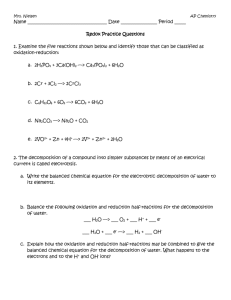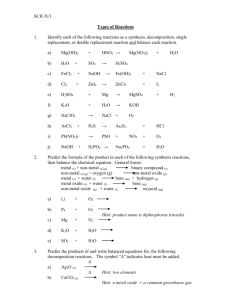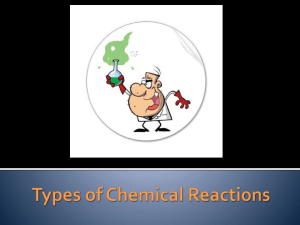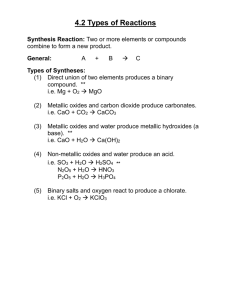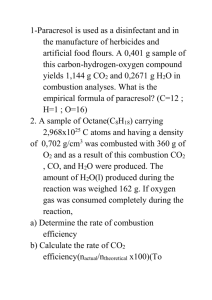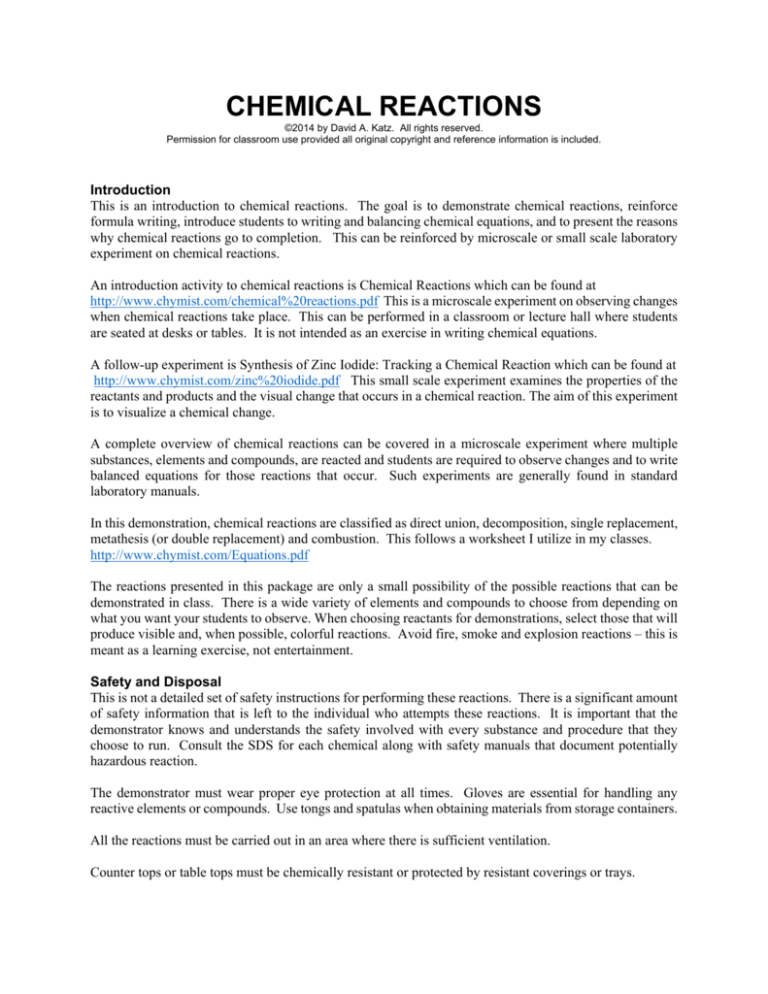
CHEMICAL REACTIONS
©2014 by David A. Katz. All rights reserved.
Permission for classroom use provided all original copyright and reference information is included.
Introduction
This is an introduction to chemical reactions. The goal is to demonstrate chemical reactions, reinforce
formula writing, introduce students to writing and balancing chemical equations, and to present the reasons
why chemical reactions go to completion. This can be reinforced by microscale or small scale laboratory
experiment on chemical reactions.
An introduction activity to chemical reactions is Chemical Reactions which can be found at
http://www.chymist.com/chemical%20reactions.pdf This is a microscale experiment on observing changes
when chemical reactions take place. This can be performed in a classroom or lecture hall where students
are seated at desks or tables. It is not intended as an exercise in writing chemical equations.
A follow-up experiment is Synthesis of Zinc Iodide: Tracking a Chemical Reaction which can be found at
http://www.chymist.com/zinc%20iodide.pdf This small scale experiment examines the properties of the
reactants and products and the visual change that occurs in a chemical reaction. The aim of this experiment
is to visualize a chemical change.
A complete overview of chemical reactions can be covered in a microscale experiment where multiple
substances, elements and compounds, are reacted and students are required to observe changes and to write
balanced equations for those reactions that occur. Such experiments are generally found in standard
laboratory manuals.
In this demonstration, chemical reactions are classified as direct union, decomposition, single replacement,
metathesis (or double replacement) and combustion. This follows a worksheet I utilize in my classes.
http://www.chymist.com/Equations.pdf
The reactions presented in this package are only a small possibility of the possible reactions that can be
demonstrated in class. There is a wide variety of elements and compounds to choose from depending on
what you want your students to observe. When choosing reactants for demonstrations, select those that will
produce visible and, when possible, colorful reactions. Avoid fire, smoke and explosion reactions – this is
meant as a learning exercise, not entertainment.
Safety and Disposal
This is not a detailed set of safety instructions for performing these reactions. There is a significant amount
of safety information that is left to the individual who attempts these reactions. It is important that the
demonstrator knows and understands the safety involved with every substance and procedure that they
choose to run. Consult the SDS for each chemical along with safety manuals that document potentially
hazardous reaction.
The demonstrator must wear proper eye protection at all times. Gloves are essential for handling any
reactive elements or compounds. Use tongs and spatulas when obtaining materials from storage containers.
All the reactions must be carried out in an area where there is sufficient ventilation.
Counter tops or table tops must be chemically resistant or protected by resistant coverings or trays.
If any flammable materials are used, or if a reaction produces sparks or flames, a fire extinguisher must be
readily available.
If anything sparks, or has the possibility of explosion, adequate safety shielding must be provided.
Use the smallest amount of material possible in performing these reactions. Drops of reactant may be
sufficient to show a reaction taking place. Use a document camera or similar device to project the reactions
onto a large screen or a wall to make the reactions visible to a class.
All flammable materials must be in small containers with secure caps. They must be removed from the
demonstration area before doing any chemical reactions.
When possible, solutions should be at a concentration of 0.1 M.
Acids and bases may have to be at concentrations ranging from 0.1 M to 3 M, depending on the reaction
being demonstrated. Use the lowest concentration that works.
Do not pass around open containers of liquids where the contents can be spilled. Line them up on the
demonstration table so the class can observe them before leaving the classroom. Dismiss the class a few
minutes early to accomplish this.
Disposal must be in accordance with all local regulations.
Materials Needed and Procedures
Direct Union or Combination Reactions
Any reaction in which two or more substances combine to form a single product is a direct union
or combination reaction. The general form of a direct union reaction is
A + B → AB
Some examples of this type of reaction:
a. A metal + non-metal
Zn + I2 → ZnI2 (This can be performed in a zip-lock bag. Add water
to initiate.)
2 Fe + O2 → 2 FeO (use powder Fe or burn steel wool)
2 Mg + O2 → 2 MgO (burn Mg ribbon)
Fe + S → FeS
(heat in a crucible)
b. Metal oxide + non-metal oxide
CaO + CO2 → CaCO3 (filter solution of CaO, bubble in CO2)
c. Non-metal + non-metal
C + O2 → CO2 (burn graphite or a stick of charcoal)
2 H2 + O2 → 2 H2O (premix gases in a pop bottle or ignite a balloon
filled with H2 – loud noise)
Decomposition Reactions
Decomposition is the reverse of combination. That is, a single reactant is broken down into two
or more products either elements or compounds. A decomposition reaction will take place
because the compound is unstable or as a result of heating or electrical decomposition
(electrolysis). The general form for a decomposition reaction is:
AB → A + B
Some examples of decomposition reactions are: (Note: any production of O2 can be confirmed
by a glowing wood splint test.)
2 HgO → 2 Hg + O2 (Perform in large test tube. Ventilation needed.
Must be able to dispose of Hg)
2 KClO3 → 2 KCl + 3 O2 (Perform in large test tube. Take extreme care
if testing for oxygen, this can be an explosion hazard)
CaCO3 → CaO + CO2 (Do this in a flask or beaker with a loose cover.
Pour CO2 over a small tea candle.)
2 H2O2
→ 2 H2O + O2 (Use yeast or MnO2 as catalyst)
To understand how to predict products of decomposition reactions, see Chemical Equations
worksheet, Section V. The Effect of Heat on Metallic Compounds.
Single Replacement Reactions
(Recent textbooks refer to these as oxidation-reduction reactions.)
A displacement reaction involves an element reacting with a compound whereby the element
displaces a second element from the compound. The general form of this type reaction is:
A + BC → AC + B
Displacement reactions usually occur between the following combinations:
Chemical Equations worksheet, Refer to Section IV, The Electromotive Series.)
(Refer to the
a. An active metal + water
Active metals in the alkali and alkaline earth groups of the periodic table react with water to
liberate hydrogen and form a hydroxide.
2 Li + 2 H2O → 2 LiOH + H2
Safety Note: Wear gloves when working with alkali and alkaline earth metals.
Perform this reaction using a very small piece of the active metal in 200 mL of
room temperature water in a 600-mL or 800-mL beaker with a fine mesh wire
gauze covering the beaker. Use a document camera, or similar, to project the
reaction on a screen.
Repeat this using small pieces of Na and K. When cutting Li, Na and K from a
larger piece, do that under the document camera to show the silvery surface of the
metal. Add one or two drops of phenolphthalein to the solution after the reaction
to show that it is alkaline.
Repeat this reaction using Sr granules, Ba granules, Ca and Mg. Group II elements
can be reacted in a large test tube. (Note: Mg does react with room temperature
water. Add two drops of phenolphthalein indicator to the water before adding the
Mg. The phenolphthalein will turn pink around the Mg as it reacts. Bubbles of H2
will be visible on the surface of the Mg.)
Collect any hydrogen from the Ca reaction only by placing a second test tube
upside down over the reaction tube. Move the test tube of hydrogen over a flame
for a “popping” sound. Depending on the amount of hydrogen collected, a flame
should be observed.
Have the class observed the difference between the solutions obtained from the
reactions of the Group I and the Group II metals. The “Earth” (or precipitates)
from the Alkaline Earth elements should be obvious.
b. An active metal + an acid
When a metal which is above hydrogen in the activity series is reacted with an acid, hydrogen is
liberated and a salt is formed.
Zn + 2 HCl → ZnCl2 + H2 (Perform in large test tube)
Mg + H2SO4 → MgSO4 + H2
Use other metals such as Ag, Cu, Sn, Pb, Ni, Co, Fe, Al, and Ca.
c. A metal + a salt
Each metal in the activity series displaces any metals below it to form a salt in solution.
Cu + 2 AgNO3
Fe + CuSO4
→ Cu(NO3)2 + 2 Ag (Perform in a large test tube.
Crystals of Ag will form over time.)
→ FeSO4 + Cu
Use other metals such as Ag, Sn, Pb, Ni, Co, Fe, Al, Ca, and Mg with solutions of chloride,
sulfate, or nitrate salts.
d. A Halogen + halide salt
A halogen (F, Cl, Br, I, At) will displace any less active halogen from a halide salt. The order
of activity decreases going from top to bottom down the halogen family in the periodic table.
Cl2 + 2 NaI
Cl2 + 2 NaBr
Br2 + 2 NaI
→ 2 NaCl + I2
→ 2 NaCl + Br2
→ 2 NaBr + I2
Use chlorine water (pale yellow-green) or bromine water (brown) with the clear,
colorless Na or K halogen salt solution.
A quick summary of the activity series of the metals: (This is an approximation.)
Most reactive
Group I
Group II
Group III (Al is the most common element we use.)
Transition elements (Mainly the first row except for Cu)
Group IV (Sn and Pb are the most common elements)
Hydrogen
Cu
Hg (used for dental amalgams)
Precious metals used for jewelry (Ag, Au, Pt)
Least reactive
Metathesis Reactions
A metathesis reaction is a double displacement reaction that usually occurs in water solution. The
general form of a metathesis reaction is:
AB + CD → AD + CB
In order to have any appreciable degree of completion of metathesis reactions, one or both of the
products must become unavailable for the reverse reaction. the principal conditions that favor the
completion of these reactions are:
(1) Formation of an insoluble compound - a precipitate
(2) Formation of a gas
(3) Formation of water
Metathesis reactions are generally classified as precipitation reactions or as neutralization
reactions.
a. Precipitation Reactions
In this type of reaction, two compounds which are water soluble react to form two new
compounds, one of which is a precipitate (i.e. insoluble in water). The precipitate is often
indicated by an arrow pointing downward, ↓, written next to its formula.
AgNO3 + NaCl
→ AgCl ↓ + NaNO3
BaCl2 + K2SO4
→ BaSO4 ↓ + 2 KCl
Repeat these reactions using different salt solutions. Choose combinations that
produce colored precipitates such as Pb(NO3)2 and KI. In cases where a lead salt,
or other heavy metal salt considered “hazardous”, only 1 or 2 drops of that salt
solution are required reducing the need for expensive hazardous waste disposal.
In order to determine which one of the products will be the precipitate requires a knowledge
of the solubilities of salts in water. The rules governing the solubility of common salts are
given below:
THE SOLUBILITY RULES
1. All sodium, potassium, and ammonium salts are soluble in water.
2. The nitrates, chlorates, and acetates of all metals are soluble in water. Silver acetate is
sparingly soluble.
3. The chlorides, bromides, and iodides of all metals except lead, silver, and mercury(I) are
soluble in water. PbCl2, PbBr2, and PbI2 are soluble in hot water.
4. The sulfates of all metals except lead, mercury(I), barium, and calcium are soluble in water.
Ag2SO4 is slightly soluble.
5. The carbonates, phosphates, borates, sulfites, chromates, and arsenates of all metal except
sodium, potassium, and ammonium are insoluble in water.
6. The sulfides of all metals except barium, calcium, magnesium, sodium, potassium, and
ammonium are insoluble in water.
7. The hydroxides of sodium, potassium, and ammonium are very soluble in water. The
hydroxides of calcium and barium are moderately soluble. The oxides and hydroxides of
all other metals are insoluble.
A gaseous product can be observed by reacting sodium carbonate or sodium bicarbonate with an
acid.
Na2CO3 + 2 HCl → 2 NaCl + H2O + CO2
The product, H2CO3 , decomposes to H2O and CO2
b. Neutralization Reactions (sometimes called acid-base reactions)
A neutralization reaction occurs between an acidic compound and a basic compound to form
a chemical salt and water.
1. Reaction between an acid and a base
HCl + NaOH
→ NaCl + H2O
H2SO4 + Mg(OH)2
→ MgSO4 + H2O
Note: Use phenolphthalein indicator to show end point.
2. Reaction between a metal oxide and an acid.
When oxides of many metals are added to water, bases are formed.
CaO + H2O
→ Ca(OH)2
Generally, these metal oxides are called basic anhydrides and they act like bases when
mixed with acids.
CaO + 2 HCl → CaCl2 + H2O
Na2O + 2 HNO3
→ 2 NaNO3 + H2O
3. Reaction between a non-metal oxide and a base.
Many non-metal oxides are classified as acid anhydrides.
These form acids when mixed with water.
SO2 + H2O
→ H2SO3
Non-metal oxides act as acids when mixed with a base.
SO2 + 2 NaOH
→ Na2SO3 + H2O
CO2 + Ca(OH)2
→ CaCO3 + H2O
Combustion Reactions
Combustion reactions generally apply to organic compounds, such as hydrocarbons, which are
used as fuels. In these cases, the compound is being burned in air (or oxygen) and producing
carbon dioxide and water as products. A general form for a combustion reaction is:
CnH2n+2 + ( 3n 1 ) O2 → n CO2 + (n+1) H2O
2
Note: The actual coefficients will vary based on the composition of the starting compound.
Some examples of combustion reactions are:
C3H8 + 5 O2 → 3 CO2 + 4 H2O
2 C4H10 + 9 O2 → 8 CO2 + 10 H2O
C2H5OH + 3 O2 → 2 CO2 + 3 H2O
Use several hydrocarbon liquids. B small quantities on watch glasses. The longer the chain,
the more yellow the flame color and the more soot will be produced. Alcohols are
considered to be “oxygenated” fuels and burn with a bluer flame.
Safety note: Keep containers of the hydrocarbons sealed and away from the combustion
reactions. Do not try to add additional hydrocarbon to any watch glass.


